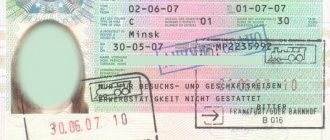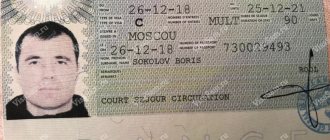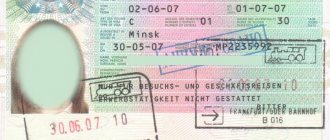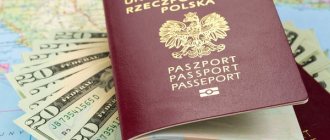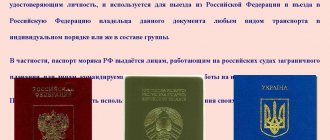Schengen visa and Schengen zone
The Schengen Agreement is where 26 European countries have agreed that there will be no border controls when traveling between them. And they will issue a joint permit that is valid in the territory of all countries included in the agreement. This is a single Schengen visa , which is valid in the territory of the so-called Schengen zone .
A Schengen visa, obtained in any Schengen country, gives the tourist the right to free movement throughout all countries of the Schengen zone, which includes: Austria, Belgium, Hungary, Germany, Greece, Denmark, Iceland, Italy, Spain, Latvia, Lithuania, Liechtenstein, Luxembourg , Malta, the Netherlands, Norway, Portugal, Poland, Slovenia, Slovakia, Finland, France, Czech Republic, Sweden, Switzerland, Estonia.
In addition, the holder of this visa can freely visit countries that have not formally signed the agreement, but are de facto participants: Monaco, San Marino, Vatican City and Andorra.
Schengen countries
Also, with a valid Schengen visa, it is possible to visit the following countries without applying for a national visa: Albania, Bulgaria, Gibraltar, Republic of Cyprus, Romania, Sint Maarten, Croatia.
Differences between a national visa and a Schengen multiple entry visa
Schengen visa is a short-term visa of category C for tourist trips to the Schengen area. Despite the fact that it is used by tourists and for tourism, it has nothing to do with non-immigrant national visas. Why? Because the Schengen Agreement operates on the territory of 26 countries, erasing internal borders.
For a national visa, the boundaries are clearly marked - one state. In addition, a national visa of any Schengen country is equivalent to a residence permit.
A Schengen visa can be issued for either a single trip or a multiple trip, and the validity period ranges from 3 days (transit) to 5 years. You are allowed to stay in Europe for up to 90 days in one half-year. Permanently living and working in any of the countries of the Schengen agreement (the Schengen agreement is linked to the article on the Schengen countries) with such a visa is strictly prohibited.
Key features of the national visa category D, as well as a comparison of the criteria with the Schengen visa are presented in the table:
| Schengen visa (cat. C) | National visa (Cat D) | |
| Reason for entry |
|
|
| Length of stay in one country | Before 90 days in half a year The maximum period for which a visa is issued is 5 years | From 90 days in half a year Validity limit is 1 year |
| Duration of stay in other Schengen states | Up to 90 days every 180 days | Up to 90 days every 180 days |
| Visa cost | 35 € | From 60 € The cost is determined according to the tariffs of the consular service in the destination country. In two cases the visa is free:
|
| Set of documents | Financial guarantees for the period of the trip, ticket and hotel reservations, itinerary sheet, sponsorship letters, economic guarantees | Employment contract, birth certificate with nationality stamped, medical report on health status, police certificate of no criminal record, financial guarantees, etc. |
| Insurance | During the trip, Schengen area | Entire duration of stay, Schengen area plus specific issuing state |
| Country of first entry | Could be anyone | Issuing State only |
| Free movement within Schengen | Yes | Yes |
the Polish national visa category D as an example . Poland is part of the Schengen zone. Accordingly, the national visa of the republic is long-term. Short-term visas are obtained under Schengen conditions, not Poland.
First of all, the difference between a multiple-entry Schengen visa (category C) and a Polish national visa (D) lies in the reason for the trip. A category D visa can only be obtained on the basis of a work contract, enrollment in a university, confirmation of Polish origin (Polish card) or for the purpose of family reunification, when one or more of its members already has EU citizenship.
Unlike a standard multi-Schengen visa, the first entry on a long-term visa must be made in the issuing country. In our example, this is Poland, not Lithuania or Latvia, but Poland. Otherwise, you will violate the visa regime and will no longer be able to apply to the Polish diplomatic mission.
The period of stay for an immigrant national visa category D is from 90 days to 1 year. In other Schengen countries - no more than 90 days in a six-month period, as in the situation with the Schengen multiple visa.
After the visa period expires, you are allowed to legalize your status and subsequently apply for citizenship.
Nuances of the national visa category D
To obtain a category D visa to any Schengen country, the applicant will have to go through all the circles of bureaucratic hell on his own. First, you need to provide a hefty package of documents directly to the embassy. Visa centers are not authorized to accept this type of application.
In addition to collecting papers, you should prepare for an interview with the consul. This is a kind of language proficiency test. When requesting a national Polish visa by origin (with a Pole card), a conversation is held on the history and culture of the country.
Next, you need not only to justify the reason, but also to prove your reliability. In Spain, for example, such proof is a local bank account. In Germany, the profession for a work visa must be included in the list of in-demand ones. If you are a representative of a rare craft, say, a glassblower or a woodcarver, you are unlikely to be given a national work visa.
Types of Schengen visa
A Schengen visa can be of several categories. The most popular and in demand is the category C visa ; it can be called a tourist visa. In addition to tourism, it is also issued for purposes such as treatment (medical), participation in sporting events, short-term business trips (work) and visiting relatives and friends (guest).
It is worth noting that transit categories A and B have been abolished, and from April 5, 2010, visas of category C are also issued for transit. The national visa category D is issued to persons who are allowed to study, work or reside permanently in a Schengen country.
New design of Schengen visa
Old Schengen visa design
The scope of application of a Schengen visa varies significantly depending on the following parameters: the validity of the visa, the number of permitted days of stay and the number of entries.
Validity
The validity period of the visa is determined by the date range:
- Start date - starting from 00 hours 00 minutes of the specified date, you have the right to enter the Schengen zone.
- Expiry date - after 23:59 on this date, the visa is no longer valid, and you are required to leave the Schengen zone before this time.
Typical expiration dates:
- Strictly for travel dates;
- For half a year;
- For one, two, three and four years;
- Five years is the maximum possible validity period of a Schengen visa.
Period of stay
A category C visa is a permit to stay in the Schengen area for a certain period of time within the validity period. Possible options for days of stay:
- Strictly the number of days of travel;
- 30, 45, 60 days;
- 90 days is the maximum possible stay for a category C visa.
It is important to note that it is not the total number of days for the entire validity period of the visa that is indicated, but the number of days allowed to stay in the Schengen countries every 180 calendar days.
Thus, if a visa has been issued with a long-term validity of more than six months (from 180 days), for example, for a year and 30 days allowed to stay, then you have the right to stay in the Schengen zone for no more than 30 days every six months (180 days).
Number of entries
Regardless of the validity period and length of stay, a Schengen visa can be issued for a different number of permitted entries :
- A single-entry visa allows the holder to enter a Schengen country once. After departure, the visa will expire, even if it was issued for a longer period of time.
- A double-entry visa allows you to enter any Schengen country without any problems, leave the Schengen area and re-enter. The visa will expire after the second departure.
- Multiple entry visa , multivisa, MULT or affectionately “multik” allows the holder to visit the Schengen zone an unlimited number of times within the validity period.
The EU proposed to tighten checks for Schengen visa recipients
Databases of countries will be integrated, where there is information not only on short-term visas, but also on long-term visas and residence permits (residence permits), which also allow free movement within the Schengen zone.
The data of those applying for a visa or residence permit will also be checked through local databases - migration and law enforcement databases. The document states that in the future VIS will be linked with Europol databases (for example, Europol will be able to receive VIS data on the availability of visas and residence permits, and vice versa), as well as with the Interpol database (for example, consulates will have access to databases of those previously convicted of terrorism and serious crimes crimes) and other EU databases.
Read on RBC Pro
Nassim Taleb - RBC: “I see a threat more serious than a pandemic”
Andrey Trubnikov: “There is only a forest, and predatory businessmen run around in it”
How 12 startups are revolutionizing global finance
“They scammed everyone I know”: the most popular crypto scam schemes
The legal act approved by the European Council will now have to be adopted by the European Parliament. The deadline for the new rules to come into force is 2023.
EU countries began introducing restrictions on entry into their territory in the first half of March 2021 due to the coronavirus pandemic. According to EU standards, all legal decisions on the procedure for crossing borders are made not by the institutions of the European Union, but by the national governments of the community countries.
German diplomatic missions in Russia will begin accepting applications for Schengen in June Society
By the beginning of August 2021, visa centers in most European countries resumed their work in Russia, but not everyone could obtain a Schengen visa, but only those who had specific travel purposes (business trips, medical care, as well as student visas, sailor visas, truck drivers, etc., depending on the country). Among the latest visa centers to open are the visa center of the Consulate General of Spain in Russia and the German diplomatic mission.
Those who already have a visa valid for at least two years will be able to obtain a German Schengen visa. The previous visa had to be issued by one of the foreign representations of Germany, and its validity should have expired no earlier than April 1, 2021. A visa will not be issued to those who want to come to Germany as a tourist.
A Spanish Schengen visa - including a tourist visa of category C - will be available to those who previously had visas with a minimum validity of one year. “Priority will be given to holders of previous two-, three- and five-year visas, as well as relatives of EU citizens,” the consulate said. At the same time, having a Schengen visa does not automatically give the right to enter the Schengen zone, and therefore it is not possible to enter, for example, Spain while maintaining the current entry restrictions, the Consulate General warned.
Rules for issuing Schengen visas in 2021
The validity period and period of stay of the issued visa in each specific case depends on the following factors:
- How accurately and completely did you provide information about the purpose of the visit?
- History of visiting both the Schengen zone and travel to other countries.
- Consul's mood.
Each application for a Schengen visa is analyzed individually, and it is possible to issue either a “longer” visa or a “shorter” one for similar conditions of applicants.
There are standard practices for issuing a Schengen visa for the first time:
- Strictly for travel dates, going abroad for the first time is the most common option.
- A six-month visa with a period of stay of 30 days, if you have a lot of stamps from other countries in your passport.
- An annual multiple visa for 90 days of stay is the best option for the first Schengen if you have a lot of travel and the consul was in a really good mood.
Currently, the consulate of each country has, if not rules for issuing long-term visas, then regularities: first they issue them for a short period, then for a year and only then for two, three or even five years, depending on the history of use of the previous ones.
In 2021, the European Union adopted new rules for issuing Schengen visas, which came into force in January 2021 . The new Regulations concern the conditions for issuing long-term multiple visas, which are now strictly regulated for all countries.
- In order to obtain an annual visa , you must first have three Schengen visas within two years.
- To get a two-year multiple visa, you need to have at least one annual visa .
- To get a five-year one two-year visa in the last three years .
The rules have become a little stricter, but it has become clearer what kind of visa you can count on if you have a certain visa history.
One of the really good innovations from June 6, 2021, it is worth noting that from January 2021 you can submit a visa application six months before your trip , and not 3 months, as before.
The visa fee in 2021 for Russian citizens is 35 Euro. For residents of Kazakhstan and Kyrgyzstan, from January 2021 the fee is 80 Euro.
The amount of the fee depends only on the citizenship of the person filing the documents, and not on the place of filing. For example, if a citizen of the Russian Federation submits documents in Kazakhstan, then a visa fee of 35 Euros is applied, and if a citizen of Kazakhstan submits documents in Russia, then the fee will be 80 Euros.
What is a Schengen visa
If you don't know what a Schengen visa means, the answer can be found in the EU Visa Code. Unlike national D, it is shorter and is issued mainly for tourism and guest visits. You have the right to order a single, double, or multiple stamp, which will allow you to freely cross the border in both directions.
Why the Schengen visa is called that way, we think, is easy to guess: it gives access to all countries of the Schengen zone, which includes 26 European countries. Having received Schengen, for example, in France, you can stay in any European country for the period allotted to you. It is desirable that the first entry be through the French border, but this requirement is not strict.
If you are wondering how to get a Schengen visa in 2021, then contact the embassy of the country you have chosen to visit. The list of documents is almost identical to what is submitted when applying for a D visa. The exception is certificates of criminal record and health, which are simply not required for short-term visas. Naturally, if you are going on a trip, then in addition to the application form, insurance, passport and income certificate, you need to provide a travel voucher or hotel and air ticket reservation. For guest voyages, an invitation from relatives is required (you can mention their willingness to bear the expenses themselves), as well as confirmation of their income, citizenship or residence permit in the EU and your family ties.
Where to apply for a Schengen visa
Recently, many “visa centers”, “first visa centers” and so on have opened up. Let's figure out who issues the Schengen visa, and who is an unnecessary and even harmful intermediary.
Firstly, only the Consulate (or the consular section of the Embassy) has the right to issue visas. It is the consul who reviews your application, who makes the decision on issuance and puts his signature on the sticker in your passport. There may be several consulates in a country, and each has its own consular district: countries and/or cities whose residents this consulate receives.
Secondly, there are accredited visa service centers . It is important to understand that an accredited visa service center is an official representative of the consulate and has the right to carry out some of the visa processing, namely: consultation on preparing documents and filling out an application form, collecting and transferring (forwarding) documents and collecting biometrics (fingerprints).
Each country can have only one accredited visa service center; it is usually listed in the information on the consulate/embassy website. The visa center service fee is set by the consulate and cannot be more or less than what is approved. The integration of the official visa service center and the country’s consulate is so close that, for example, registration at the Spanish consulate takes place on the visa center’s website.
All! This concludes the options for where to apply for a Schengen visa!
Other organizations are intermediaries that serve no purpose other than making the service more expensive for you! They can be separate companies or exist within the framework of a travel agency and be called whatever you like: “visa visa center”, “first visa center” - it doesn’t matter, these are intermediaries, since only the consulate has the right to issue Schengen visas and only an accredited visa service center has the rights collect documents and fingerprints.
There is not a single adequate argument to contact an intermediary to obtain a Schengen visa. The intermediary is not authorized to handle the registration, but he can make a mistake in your documents and extend the receipt period by several days without any problems. And the most interesting thing is that you will still have to visit an accredited visa service center or consulate to take biometrics. Bingo!
Consulate or accredited visa service center
Choosing a place to submit documents is quite simple. Consulates are usually represented only in a few cities, and if your city has a consulate of the desired country, then it will be cheaper to contact it.
Attention: some consulates do not process visas, but completely delegate these responsibilities to visa service centers.
If there is no consulate in the city, then the choice falls on an accredited visa service center, fortunately they are represented almost everywhere. The additional visa center fee is usually much less than the cost of traveling to the city with the Consulate.
Sometimes there are situations when it is advisable to contact a visa center, even if there is a consulate in the city. For example, when at the height of the season, an appointment at the Consulate takes only six months, but at the visa center you can submit documents within a few days.
External visa visas
Some inexperienced travelers will probably ask: “Why do we even need to know what Schengen visas look like in a passport?” In fact, it is important for anyone traveling abroad to know and understand the visa requirements. This way you can determine the types of visa issued, country, frequency of entry and many other useful data. This is very convenient, especially if you have many current visas.
Below you can see what a standard Schengen visa looks like now.
Visa decoding
Let's try to decipher it. The first thing we see is “Valid for”. This column indicates the country that issued the visa. A Schengen visa can be intended for travel throughout the Schengen territory, or it can be issued for travel strictly to a specific country. The country is indicated by a numerical code. If travel throughout the Schengen area is allowed, then this will be indicated in this column, but in the language of the country at whose embassy you originally issued the visa.
The “From” and “Until” columns indicate the validity date of the visa. Or, to be more precise, a start date and an end date. Do not confuse the start date and the issue date. They may vary. Often the start date of the visa coincides with the expected date of travel; you indicate this information in the visa application form.
Next we see the column “Type of visa”. The visa category (its type) is indicated here. We remind you that the Schengen visa may differ depending on the category. Now they issue visas of categories A, B, C and D. The standard tourist visa is category C. If you are going on vacation or visiting, then most likely this category will be indicated in your passport.
The column “Number of entries” indicates the number of entry permits. If the visa is single-entry, then “01” is indicated, double-entry - “02”, multiple-entry - “MULT” (also known as multivisa). A single-entry visa is given to those who have never been to Schengen countries before. Double entry visas are issued in order to subsequently issue multiple visas. A multiple visa is the most desirable, but only those travelers who have been abroad many times can get it.
Next we see the “Duration of stay” column. It indicates how many days you can stay in Schengen countries during the validity of the visa. The number of days is determined by the visa officer based on the purpose of the trip and the visa category. An ordinary tourist can most often stay abroad for no longer than 90 days.
The remaining points do not play such an important role for us, so we will not go into their detailed study.
In addition to all the information listed above, the visa sticker includes your photo. This is one of the most important markers for identifying an individual, so the photograph must be taken in accordance with the rules. If your real appearance and the photo on your visa do not match, this raises many questions and suspicions. Read more about how to properly take photos for a visa in this article.
Documents for a Schengen visa
Although the Schengen visa is uniform and subject to the general regulations of the European Union, the set of documents may differ slightly from country to country. The main difference lies in whether bookings of accommodation without payment are suitable, in what language a printout of airline tickets must be provided and the type of bank statement - these points are not spelled out in the general requirements, so different consulates interpret them slightly differently.
The general recommendation for collecting documents is relevant for all countries: when the consul examines your documents, he should not have questions for which he cannot find answers in the documents provided .
- The duration of your visit to the Schengen zone must coincide with the period of your booked stay. It should not be the case that tickets are for 2 weeks, but the hotel is booked only for 3 days. Where are you going to live the rest of the time? Booking.com will help you find and book suitable accommodation.
- Internal movements should also preferably be covered by documents: if you are going to stay in different cities, then you must provide plane/bus/train reservations between these cities (convenient to buy on Omio).
- Insurance for the entire duration of the trip is required when submitting documents. Check your cards, perhaps insurance is already provided by the bank or can be issued at low rates; if not, then you can choose the optimal insurance on the Cherehapa and Instore.Travel services.
- And a tip that many people don’t know about: if you are planning a really difficult trip that tickets and reservations do not cover, for example, a hiking trip, then you have the right to provide a cover letter with a set of documents. Describe your planned route and other travel details in free form.
How to extend a Schengen visa
If the Schengen visa expires and a trip to Europe is planned again, it becomes necessary to extend the permit. In most cases, the expiration of the document's validity period is final and requires the production of a new one. The second time, getting a Schengen visa is much easier than initially, if only because the applicant now has experience in collecting documents and knows where to apply.
The loyalty of consular officers to respectable citizens who already had Schengen visas is also obvious. The likelihood of a positive response increases with each subsequent stamp received, as does the validity period provided and the number of entries. In some Schengen countries, when you submit an application, consulates issue a new visa the day after the old one expires.
You can extend your Schengen pass:
free of charge if evidence of force majeure is provided, which prevents you from leaving the country before the visa expires;
by paying the consular fee if personal circumstances or other compelling reasons arise that prevent leaving a state that is a signatory to the Schengen Convention.
The expiration of a Schengen visa can be delayed in extreme cases for up to 90 days. An application for renewal of the permit must be submitted to the police department for foreigners. But it is worth noting that the chances of a visa extension are very low - you need to make really strong arguments.
Schengen visa application form
It is important to understand that the Schengen visa application form is not a test or verification. A questionnaire is a standardized form where you describe the purpose of your visit. There are no right or wrong answers. You just need to accurately and completely describe why you need an entry permit.
Here are some basic recommendations for filling out the form:
- Don't lie or make it as believable as possible.
- Check that the names of places of work and place of residence in the application form and the set of documents match.
- Check that the dates in the application form match the dates in the documents.
Types of Schengen visas and their designation
There are several types of Schengen visas, issued depending on the purpose of the trip. First of all, they are divided into immigration and non-immigration. Let's take a closer look at the latter.
Category A is a transit visa, which is issued for making a transfer in the Schengen area. The holder of this visa cannot leave the airport. This visa is not required for citizens of those countries that have signed a visa-free regime agreement with the Schengen countries. Russian citizens do not need to obtain this category of visa, except for cases of transit at a French airport with departure from Egypt, Ukraine, Belarus, Georgia, Moldova, Azerbaijan and Armenia.
Category C – short-term tourist visa. Schengen visa category C is the most popular type of document that all travelers receive.
It is divided by duration into subcategories:
- C1 – issued up to 30 days;
- C2 – up to six months;
- C3 – up to 3 years;
- C4 – up to 5 years.
Category D is a long-term national visa, according to which you can stay in the Schengen area for more than 90 days. The registration procedure is established by each state. This visa is issued in cases where a long stay in the territory of the Schengen countries is necessary.
- Studying at the University
- Employment
- Cultural exchange (for artists)
- Sports (invitation for athletes)
The process of obtaining it is longer and more complex, since it requires confirmation of the indicated intentions.
The following types of visas are very rarely issued:
- FTD and FRTD are transit visas for travel to Kaliningrad.
- LTV – allows you to visit only the country that issued it. Transit along it is prohibited.
Depending on the length of stay, the following types of visas are distinguished:
- One-time
- double
- multiple
With a single-entry visa you can enter and exit only once, with a double-entry visa twice. A multiple-entry visa (or multivisa) provides for visiting Schengen countries an unlimited number of times, subject to the deadline of the issued document and the number of days of stay.
When submitting documents, the applicant indicates in the application form the desired duration of the visa to be received, but the consulate makes decisions independently, based on the documents submitted and the applicant’s previous Schengen visas.
Selecting a country to apply for a Schengen visa
According to the rules, you are required to apply for a visa to the country that is the main purpose of your visit. This should be understood as the country in which you plan to spend more days if you plan to visit several countries.
It is important that it does not exist and, moreover, has never existed. Someone came up with it, and the rest, for some unknown reason, reprinted it, and away we go...
Let's consider several cases of choosing a country for submitting documents:
- Let's say you are planning to visit Italy, and only Italy is the easiest option, you need to apply for a Schengen visa from Italy.
- If your trip covers several countries, for example, France, Germany and the Czech Republic, then the country in which you will spend a total of more days . If it so happens that the days of stay are equal, then you have the right to choose any country.
There are situations when it is more convenient to submit documents to a certain country, be it a shorter queue for receiving, the proximity of a visa center or a simple package of documents - then it makes sense when planning a trip to make sure that the desired country has at least one more day of stay, and with a clear conscience, submit documents to the representative office of this country.
National visa
Visa to Italy
What is the difference between a Schengen visa and a national one? The national one allows its holder to stay exclusively on the territory of the state that issued it. For example, having received such permission from Spain, you have the right to be there freely, but at the same time you will be prohibited from visiting other countries of the union. The only exception is the need for transit.
Most often, a regular pass is issued:
- when the applicant got a job abroad;
- when the applicant entered an educational institution abroad;
- if necessary, the reunification of husband and wife;
- persons who participate in cultural or sporting events;
- when in his previous trips the applicant violated the rules for using a visa (for example, having received a visa from Spain, the tourist spent only one day there, while he traveled in France for a whole week).
May be:
- Single entry (allowed to cross the state border back and forth once).
- Double entry (allowed to cross the border back and forth twice).
- Multiple (allowed to cross the border an unlimited number of times in both directions).
The main difference between this type of permit is that it does not limit the length of a tourist’s stay abroad. That is, if the permit is valid from 01/01/2017 to 01/01/2022, then its holder has every right to stay abroad for all 5 years. However, there is one important nuance here: to return to their homeland, a tourist will need to apply for a transit Schengen pass if there is a need to cross the borders of other countries of the union. If you are in Finland, there is no need for a transit pass.
The regular visa type is designated by the letter "D"
Location of consulates and names of visa centers
| A country | Consulate | Visa Center | |
| Austria | Moscow St. Petersburg Nizhny Novgorod Ekaterinburg Nur-Sultan Almaty | VFS Global | Obtaining a visa to Austria |
| Belgium | Moscow St. Petersburg Nur-Sultan Almaty | TLScontact | Obtaining a visa to Belgium |
| Hungary | Moscow St. Petersburg Nizhny Novgorod Ekaterinburg Kazan Chelyabinsk Nur-Sultan Almaty | VFS Global | Obtaining a Hungary visa |
| Germany | Moscow St. Petersburg Ekaterinburg Novosibirsk Kaliningrad Nur-Sultan Almaty Bishkek | VisaMetric | Obtaining a visa to Germany |
| Greece | Moscow St. Petersburg Novorossiysk Nur-Sultan Almaty | Global Visa Center World | Obtaining a visa to Greece |
| Denmark | Moscow, Saint Petersburg | VFS Global | Obtaining a visa to Denmark |
| Iceland | Moscow, Saint Petersburg | VFS Global | Obtaining a visa to Iceland |
| Italy | Moscow St. Petersburg Ekaterinburg Volgograd Kaliningrad Krasnodar Lipetsk Samara Chelyabinsk Nur-Sultan | Italy VMS | Obtaining a visa to Italy |
| Spain | Moscow St. Petersburg Ekaterinburg Nur-Sultan Almaty | BLS International | Obtaining a visa to Spain |
| Latvia | Moscow St. Petersburg Kaliningrad Nur-Sultan Almaty | Pony Express | Obtaining a visa to Latvia |
| Lithuania | Moscow St. Petersburg Kaliningrad Irkutsk Nur-Sultan Almaty | VFS Global | Obtaining a visa to Lithuania |
| Liechtenstein | — | — | Visa issues are resolved through the Swiss representative office. |
| Luxembourg | Moscow St. Petersburg Ekaterinburg Cherepovets Magnitogorsk | Consular Section of the Luxembourg Embassy in Moscow | Obtaining a visa to Luxembourg |
| Malta | Moscow, Saint Petersburg | VFS Global | Obtaining a visa to Malta |
| Netherlands | Moscow St. Petersburg Yuzhno-Sakhalinsk Nur-Sultan | VFS Global | Obtaining a visa to the Netherlands |
| Norway | Moscow St. Petersburg Arkhangelsk Murmansk Nur-Sultan Almaty | VFS Global | Obtaining a visa to Norway |
| Portugal | Moscow | VFS Global | Obtaining a visa to Portugal |
| Poland | Moscow St. Petersburg Irkutsk Kaliningrad Nur-Sultan Almaty | VFS Global | Obtaining a visa to Poland |
| Slovenia | Moscow, Saint Petersburg | VFS Global | Obtaining a visa to Slovenia |
| Slovakia | Moscow St. Petersburg Astrakhan Vladivostok Perm Krasnoyarsk Omsk Nur-Sultan Karaganda | VFS Global | Obtaining a visa to Slovakia |
| Finland | Moscow St. Petersburg Nur-Sultan Karaganda | VFS Global | Obtaining a visa to Finland |
| France | Moscow St. Petersburg Ekaterinburg Nur-Sultan Almaty Bishkek | VFS Global | Obtaining a visa to France |
| Czech | Moscow St. Petersburg Ekaterinburg Nizhny Novgorod Nur-Sultan Almaty | VFS Global | Obtaining a visa to the Czech Republic |
| Sweden | Moscow St. Petersburg Nur-Sultan Almaty | VFS Global | Obtaining a visa to Sweden |
| Switzerland | Moscow St. Petersburg Nur-Sultan Almaty Bishkek | TLScontact | Obtaining a visa to Switzerland |
| Estonia | Moscow St. Petersburg Pskov | VFS Global | Obtaining a visa to Estonia |



